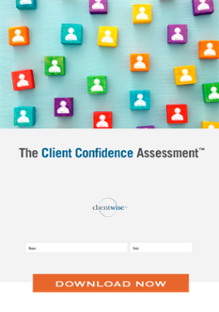Gauging your clients’ confidence
Despite the bounce-back of financial markets we’re currently seeing, our world has indeed changed. Even if this unprecedented loosening of monetary policy by the Fed can somehow buoy the markets long enough for the economy to get back on track, there will be damage done – and no shortage of client uncertainty regarding their financial plans, their portfolios and the security of their futures.
In my 30+ years working with a wide and diverse group of advisors, I’ve come to understand that the greatest value you bring to your relationships can be categorized in two distinct boxes: the technical skills you bring to the relationship in the way of sound advice and guidance, thoughtful planning and risk-appropriate investment management; and the behavioral component of being able to understand and empathize with your clients’ fears, biases and potentially destructive inclinations in a way that leads them to making smarter decisions.It’s at the intersection of those two skills – especially when you add a volatile and unchartered economic situation to the mix – where great financial advisors rise to the occasion.
A recent “Assessing the Value of Advice” study published by Vanguard this past September provides statistical validity to this belief. The study found that only 55% of the value associated with financial advice is “functional” (e.g., creating financial plans, crafting, overseeing and rebalancing portfolios, and other planning services). Almost half (45%) of the value, however, is directly attributable to your skill in managing client emotions. And that begins with understanding the basis by which each client is either confident or not confident and why so you can help them make necessary adjustments accordingly.
Are they confident and should they be?
When it comes to gauging the confidence of your clients, the functional and the behavioral are two related but very distinct questions. If a client is confident, are they justified or unjustified in that conviction? Conversely and far more commonly, if they aren’t confident, is there an actual problem driving this uncertainty (e.g., excessive spending or unrealistic goals) that needs to be addressed, or are they simply lacking confidence despite having enough projected wealth to achieve all their goals?
At ClientWise, we’ve created The Client Confidence AssessmentTM specifically for this purpose – to help you better categorize where each of your clients resides along the “confidence spectrum” and then identify specific follow-up actions that will move each further along towards greater confidence. It’s a simple assessment, but one which can be immensely helpful in ensuring firm-wide accountability for more confident clients who in turn become stronger advocates.
Understand that you may have to engage in some difficult conversations about cutting expenses and/or scaling back some goals with those clients who justifiably lack confidence because their financial goals are at risk. But as uncomfortable as those discussions may be, you owe it to your clients to have them sooner rather than later. And for those clients who are on-track but still apprehensive, the simple act of walking them through a detailed portfolio review and financial plan stress test – showing them that they’re ready for whatever the future may hold – can help to solidify relationships that will last for generations.
There’s a long way to go and a great deal of work still to be done before we can all put this pandemic in the rear view mirror. As with any major global crisis, however, there will inevitably be long-term and permanent social, economic and systemic changes that result from COVID-19. In the meantime, don’t allow unnecessary fear to erode your clients’ confidence and potentially derail their plans as a result of their emotions and behavioral biases.
Coaching Questions from this article:
- With face-to-face meetings not a current option, how have you been reaching out to clients in general and conducting reviews in particular? What specific actions (e.g., stress-testing their plans) are you taking to help replace their fear with confidence?
- Think about the ability of your team members to accurately identify the underlying emotions and behavioral biases of particular clients. What steps could you commit to taking that will help to sharpen those skills?
- How might you and your team strengthen the frequency, mode and messaging of your client communications during this pandemic to assuage fears and instill greater confidence?



